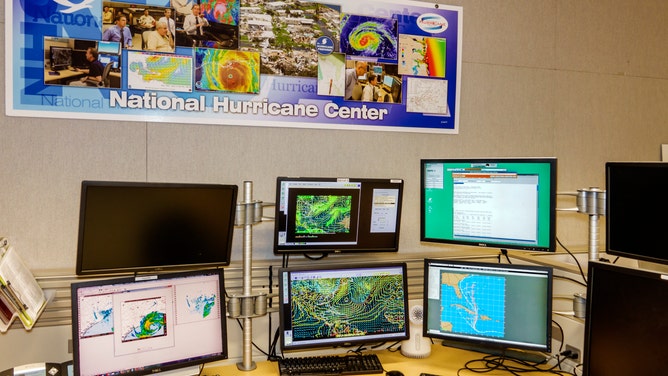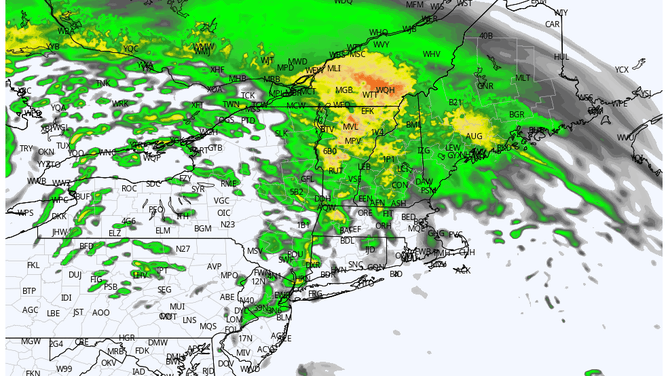What does ‘Z’ time mean on weather maps?
If you follow a meteorologist on social media, odds are they've talked about "Z" time. Here's how to find out what time they mean in your neighborhood.

(Jeffrey Greenberg/Universal Images Group / Getty Images)
When the weather starts to get exciting or perhaps even dangerous, social media feeds fill with professional and armchair meteorologists giving their thoughts on the upcoming storms.
But the weather community is filled with jargon and acronyms that would make any government bureau proud.
FOX Weather is here to help as translators.
What's with the "Z" on time stamps?
One of the most common jargon you might see in a weather post is noting "Z" as a time reference – commonly paired with notes about computer forecast models or other timed weather products, such as weather balloon soundings. Such an example might be:
"The new 12Z models show a big increase in the storm threat – much larger than what the 0Z models had shown last night."
After days of disagreement the 0Z Euro (left) and 12Z GFS (right) now look remarkably similar (Sorry Far North Sound). This is a snapshot of total snow by 10am Friday. Don't take these totals as gospel as they will continue to fluctuate but gives a general idea. #wawx pic.twitter.com/5hgwB2gFa1
— Scott Sistek (@ScottSeattleWx) February 9, 2021
Think of Z like you would if you saw "GMT" or "UTC." "Z" time is short for "Zulu" time from the NATO Phonetic Alphabet, and is set to the same time as global time standard "UTC" (Universal Time, Coordinated) -- which is the same time as the old Greenwich Mean Time, or GMT (Got all that?)
HOW TO WATCH FOX WEATHER ON TV
They're all generally considered the official World Clock time zone, from which all the other time zones are set. This time zone is based at the Prime Meridian - where 0 degrees longitude sits. This meridian cuts through Western Europe, including England and France - which are the source of the GMT and UTC time zone names, respectively. The meridian then cuts south into western Africa.

But the U.S. military takes a different naming convention. It assigns the Prime Meridian time zone with the letter Z, and then each time zone is given a letter. Going east from the meridian, the next time zone starts with an ‘A’ designation and counts up through ‘M', until it reaches the International Dateline on the opposite site of the planet. There, it resets to ‘Y’ and counts backward to ‘N' and… I could do a whole separate story on that, so let's say it's complicated and check this map if you're curious.
The time zones are given a letter but are usually referred to by their corresponding name in the aforementioned phonetic alphabet. ‘Z’ is Zulu time; ‘N’ is November time, ‘S’ is Sierra time, etc…
(A fun fact with military jargon: The Pacific Time Zone is considered "Uniform Time," which speaks to the phonetic alphabet letter ‘U' assigned to the time zone and not, as you might expect, an actual uniformity to time. Meanwhile, in Hawaii and some other Pacific Island nations designated in the ‘W’ time zone, no matter what time the clock says, that means it's always Whiskey time. In parts of Russia and southeastern Asia in the ‘G’ time zone, it's always Golf time.
THE HISTORY OF DAYLIGHT SAVINGS TIME
Suffice to say: ‘Z’ time is the same as ‘UTC’ time which is the same as the old ‘GMT’ time.
In the original example above, the Z time notes the time of day when these particular computer models were "initialized" or started.
Most of the leading global models run at least four times a day with forecasts that begin at 0Z, 06Z, 12Z and 18Z. (Some models run every three hours, and we have some now that run every hour).
What time is ‘Z’ time?
For Eastern Standard Time, Zulu time is five hours ahead (four hours during Daylight Saving Time). With Pacific Time, it's eight hours ahead (seven hours during Pacific Daylight Time).
NOAA's ZULU TIME CONVERSION CHART TO AMERICAN TIME ZONES
In our 12Z example, the model began initializing at 8 a.m. Eastern Daylight Time and 5 a.m. in the Pacific Time Zone. Weather charts use the 24-hour clock, like the military, so you may see such times given as 18Z or 21Z, which is the same as 6 p.m.Z and 9 p.m.Z times, respectively.
The tricky 0Z time: When tomorrow is still today
One tricky part is that meteorologists have to get used to subtracting a day when you work with a map initialized at 0Z.
HOW DAYLIGHT SAVING TIME CAN MESS WITH YOUR HEALTH
0:00 on the 24-hour clock is the equivalent to midnight, which becomes "tomorrow." If you're peeking at weather charts on your own, be careful as 0Z charts will be time-stamped as a day ahead relative for North America.

A HRRR forecast model from WeatherBell.
(WeatherBell, Inc. / FOX Weather)
For example, a computer model might show a map forecasting for 0Z on Feb. 9. That forecast is late evening on February 8 in the United States. (Remember: Midnight Z time on, say, a Thursday morning is 8 p.m. EDT on Wednesday.) Don't forget to adjust the date mentally, or you'll be a day off! The same goes for any 03Z or 06Z forecasts, depending on your time zone.
A better way to quickly decode model times is thinking of 12Z as morning run of the model and the 0Z as an evening run, with 18Z as midday and 06Z as the overnight run.
These conversions work for all other fields that use global time, though most use "UTC" instead of "Z."